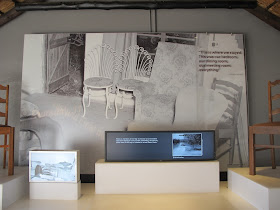LiliesleafFarm is one of the most engaging museums I've visited in a long time. If you
are interested in the history of the struggle against apartheid you really
shouldn't miss out on spending a few hours here.
Back in the
early 1960s when this farm was used as a secret meeting place for top anti-apartheid leaders, Liliesleaf and the area around it, Rivonia,
was way out in the sticks. A rural idyll with a few farms and camping grounds
it was deemed far enough away from the spotlight to be a good safe house for
those such as Mandela who were now underground, but also near enough to the
city to be a functional headquarters for the opposition.
A white family, who were part of the movement, was tasked with keeping up a front of being a typical white farming
family. The black members of the group pretended to be workers and for a while few suspicions were aroused and a great deal of planning and debate about how to defeat apartheid took place here.
Nelson Mandela, who the media were then dubbing 'the black pimpernel', came here to work on plans for
launching an armed struggle against apartheid. His cover was that he was a
caretaker named David and according to testimonies the neighbours had
no clue who he really was, but were in any case charmed by his well-spoken and
gracious manner.
 |
| This interactive table in the main room of the farmhouse explains exactly what was being planned here and provides biographies of all the anti-apartheid activists involved |
Of course as
we know from history, somehow the true nature of life on Liliesleaf Farm was
eventually leaked to the authorities and the farm was raided. Those who were
captured were tried at the Rivonia Trial and following the verdict they were sentenced to spend the next decades of their lives in jail.
Nobody really
knows for sure how the authorities found out about the Liliesleaf safe house.
At the museum the mystery is presented almost as a game of Cluedo. Was it the
maid who overheard them listening to the banned Radio Freedom station? Was it
the campers at the nearby caravan site who spotted suspicious looking black men
arriving in the dead of the night? Or was there are spy in the ranks? Nobody
really knows for sure.
One of the
really enjoyable things about the Liliesleaf museum is how all characters of the
story get the chance to air their voice. In different rooms there are different
displays with videoed interviews from key players. Some of the most interesting
people interviewed include the chief of the secret police who led the invasion
of the farm, Rusty Bernstein and Ahmed Kathrada who were arrested here and the now grown-up children of the poor black workmen who lived on the farm and
actually had no idea what was going on around them at all.
 |
| The video in this room features an interview with the former secret police chief. He visited the farm once it was a museum to be interviewed and said with amazement: 'yes it was exactly like this!' |
Different
buildings are dedicated to different elements of the struggle and the after
effects of the Rivonia raid. One room contains heart-breaking photos of the
children of the Sisulu family who effectively became orphaned after both
parents were arrested.
In another
you hear the story of Bram Fischer. He was an Afrikaner, a communist and thoroughly
devoted to the anti-apartheid movement. He worked as a lawyer for Mr Mandela
and the others before himself being sent to prison. He devoted his life to the
struggle, but sadly never saw apartheid fall as he died of brain cancer whilst
under home arrest in the 1970s. Mandela said of him later: "Bram was a free man
who fought against his own people to secure the freedom of others".
 |
| Bram Fischer |
And of course
if you are interested in the Rivonia Trial itself there is an abundance of
information including a recording of Mandela's famous closing statement in
which he told the court that for the freedom of South Africa he would be
prepared to die.
 |
| You can find Get Well Soon cards addressed to Madiba across Johannesburg at the moment |
In amongst
all the serious learning there is to be done here, there are some fun exhibits
as well. The secret safari bus is by far the best such exhibit.
During the
1980s as the ANC was continuing to prepare for the moment when they may be
forced into an all-out armed struggle, an ingenious idea was hatched to get
weapons from neighbouring countries into South Africa. The dangerous goods would
be transported in on an overland safari bus. A tour agency called Africa Hinterland was formed, reaching
out to young European and Australian backpackers looking for African adventures. The special bus was kitted out with secret hiding places for the guns under the tourists' seats. Over the years hundreds of travelers enjoyed their road trip
through Africa oblivious to the fact that they were acting as the perfect cover
for a top secret anti-apartheid mission.
Getting
there:
Located up in
Rivonia, one of the northern suburbs of Sandton, this is not the easiest place
to get to under your own steam, although not impossible. You can take the
Rivonia Gautrain bus from Sandton station. Get out at 11th Avenue (almost at the end of the route) and from there you have about a 20 minute walk.
p.s
Now I know most people don't go to museums to eat cake, but I just had to mention the muffins in the museum café - the best I have ever eaten. Seriously, they were that good. They may be huge but do not even try to convince yourself that you won't eat a whole one, you will!







No comments:
Post a Comment